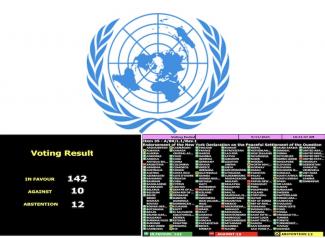Between Isolation and Recognition: Israel, Palestine and the New Global Consensus
On September 12, 2025, 142 nations voted in favor of a two-state solution, 10 against, and 12 abstained — within 24 hours of the Israeli prime minister declaring that Palestine would never be a state. Major countries, including Saudi Arabia, France, and India, have endorsed the resolution, acknowledging Palestinian suffering. This raises a critical question: Will the adoption of the two-state resolution change the Israel–Palestine conflict, or will the cycle of violence continue?
The United Nations General Assembly (UNGA) reaffirmed its commitment to establishing an independent Palestinian state through the New York Declaration, co-chaired by France and Saudi Arabia. The declaration outlined specific, time-bound, and actionable steps toward two sovereign states, urging an immediate end to the Gaza war and the release of hostages. It called on Hamas to dismantle its regime in Gaza, disarm, and transfer authority to the Palestinian government, a move praised by the Palestine Foreign Ministry as an "actionable plan," to end Israeli occupation and protect Palestinian rights.
The humanitarian aspect is central to this renewed effort. Half of Gaza's population is already in IPC Phase 5 (Famine/Catastrophe), facing widespread malnutrition. IPC Phase 05 represents the most severe level on the Integrated Food Security Phase Classification (IPC) scale. According to IPC research (May 2025), Gaza is expected to reach catastrophic hunger levels by the end of September. However, on the same day as the UN vote, Israel conducted airstrikes that killed 59 Palestinians, reportedly targeting more than 500 sites linked to Hamas infrastructure.
Both sides have been accused of serious human rights violations. According to Chris Sidoti, a member of the UN Commission of Inquiry, Israeli forces have used sexual violence, public humiliation, and threats of rape against Palestinian women. Similarly, Hamas fighters were accused of sexual assaults on Israeli women during the October 7, 2023, attacks. By acknowledging atrocities committed by both sides, the declaration presents itself as a moral and balanced call for peace, not one driven by political partisanship.
Evolving Geopolitical Context
The global legitimacy of the two-state solution is unprecedented. Despite boycotts by Israel and the United States, 142 countries supported it, indicating a shift in diplomatic momentum. The resolution not only enhances Palestinian recognition but also puts pressure on Israel to adjust its strategy. The declaration’s calls for a permanent ceasefire, the unification of Gaza and the West Bank, and a UN stabilization mission have the backing of the UK, France, and Australia, highlighting the growing consensus on Palestinian statehood. These developments shift the diplomatic balance, making the two-state solution the ultimate goal.
The resolution not only strengthens Palestinian recognition but also pressures Israel to recalibrate its strategy. The declaration’s demand for a permanent ceasefire, the unification of Gaza and the West Bank, and a UN stabilisation mission enjoys the backing of the UK, France, and Australia, underscoring the evolving consensus around Palestinian statehood.
The political contradictions still stand out. After the UN vote, Israel attacked targets in Lebanon, Syria, Qatar, Tunisia, and Gaza, increasing regional instability. Israel called the UN resolution a “political circus,” arguing that it did not classify Hamas as a terrorist organization. While critics say the declaration unfairly isolates Israel, its wide moral symbolism has already changed the diplomatic scene. A continued Israeli refusal of the two-state solution could deepen its international isolation, while acceptance might lead to long-term stability.
Turning diplomatic symbolism into real results remains challenging. The split in Palestinian political authority, with Hamas firmly in Gaza and the Palestinian Authority fighting for legitimacy in the West Bank, creates a structural obstacle. The suggested transfer of Gaza’s governance to a unified Palestinian administration would need not only internal reconciliation but also international guarantees, possibly through a UN-led stabilization or peacekeeping mission. Israel’s political divisions, influence from hardline settler groups, and the ongoing expansion of settlements in the West Bank further diminish the chances of establishing a contiguous Palestinian state. Without credible enforcement mechanisms and ongoing regional engagement, the New York Declaration risks becoming just another aspirational document, like the Oslo Accords (1993) or the Arab Peace Initiative (2002), both of which failed to deliver tangible sovereignty for Palestine.
Yet, the global response in 2025 marks a potential turning point. The moral fatigue from ongoing bloodshed, humanitarian crises, and diplomatic deadlocks has created new pressure on both sides to reconsider their maximalist positions. A sustained multilateral coalition involving Arab states, the European Union, and neutral actors like India could pave the way for a pragmatic approach that combines incremental recognition, economic rebuilding, and confidence-building measures to repair decades of mistrust. Ultimately, the path to a two-state solution remains difficult, but the renewed global consensus keeps the vision of coexistence and mutual recognition alive.
Conclusion
The New York Declaration symbolizes a diplomatic awakening to end one of the world’s most protracted conflicts. The declaration, with 142 votes, emphasizes that the world no longer accepts an endless cycle of violence and demands accountability from Israel. While it might not bring immediate peace, it signifies a collective rejection of perpetual violence and a push for accountability. The two-state solution remains filled with political, territorial, and security challenges, but as this vote shows, the idea of coexistence persists.
